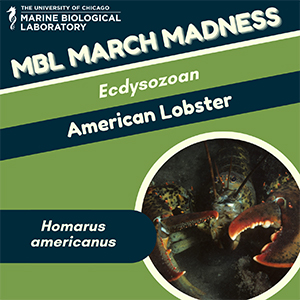MBL March Madness: American Lobster


Homarus americanus, or “true lobster,” is the heaviest crustacean in the world. MBL researchers have studied the causes of shell disease in lobsters, as well as studying the chemical ecology of H. americanus to understand how marine animals sense their environment. This work has contributed to commercial lobster fishing management and even helped to build navigation algorithm models for autonomous underwater vehicles.
Cool facts
- It is typically found at depths of 13-164 feet but can be found up to 1,570 feet below the surface.
- By assessing chemical excretions, lobsters have been shown to “recognize” other individuals up to two weeks after an interaction.
- In 1977, lobstermen off Nova Scotia caught the largest lobster on record. It weighed 44 pounds, 6 ounces.
(ID Card Photo Credit: Derek Keats, Wikimedia Commons)
More about lobsters and the MBL
Plastics Suspect in Lobster Illness | MBL Archives
Select Publications
Molly Jacobs, Hans Laufer, James Stuart, Ming Chen, and Xuejun Pan (2012) Endocrine-Disrupting Alkylphenols are Widespread in the Blood of Lobsters from Southern New England and Adjacent Offshore Areas. Journal of Shellfish Research doi.org/10.2983/035.031.0216
Karavanich, C., & Atema, J. (1998). Individual recognition and memory in lobster dominance. Animal Behaviour, 56(6), 1553–1560. doi.org/10.1006/anbe.1998.0914
Moore PA, Scholz N, Atema J. (1991) Chemical orientation of lobsters, homarus americanus, in turbulent odor plumes. J Chem Ecol. doi.org/10.1007/BF00983763
Karnofsky EB, Atema J, Elgin RH. (1989) Field Observations of Social Behavior, Shelter Use, and Foraging in the Lobster, Homarus americanus. Biol Bull. doi.org/10.2307/1541982
Devine, D V, and Atema, J (1982) Function of chemoreceptor organs in spatial orientation of the lobster, Homarus americanus: differences and overlap. Biol Bull. doi.org/10.2307/1541504
Division: Ecdysozoa
Ecdysozoans are the largest group within the animal kingdom and comprises arthropods (insects, spiders, and crustaceans), as well as nematodes such as roundworms. All organisms in the Ecdysozoan superphylum have an exoskeleton and shed or molt that cuticle layer in order to grow. Learn more about Ecdysozoans here.
Meet the Other Ecdysozoan Organisms
-
- Beach Hopper (Parhyale hawaiensis)
- Sea Spider (Pycnogonida pantopoda)
- Atlantic Horseshoe Crab (Limulus polyphemus)
What is MBL March Madness?
Based on the March Madness NCAA basketball tournament, during MBL March Madness, popular MBL organisms face off for your votes. YOU have the opportunity to decide what organism is crowned victorious by voting for your favorite organisms in a series of head-to-head match-ups. Voting will take place on the MBL social media channels from March 29 - April 7.